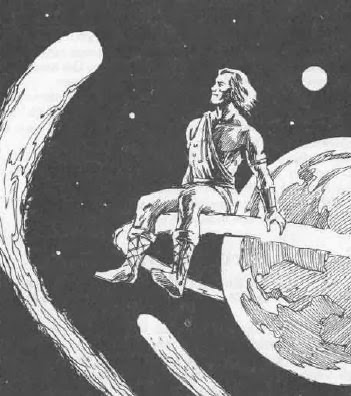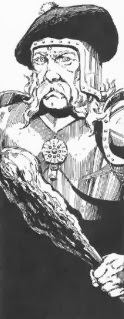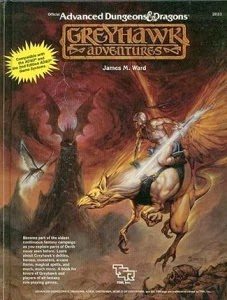Next up is Celestian, “The Far Wanderer.” Again, we see some of the verbiage in the description taken verbatim from the earlier Guide to the World of Greyhawk. His stats once again go down – in the earlier work he is a 14th level magic-user and 15th level ranger, but his avatar is merely a 13th level magic-user. His magic resistance also gets cut in half, although the power of his magical abilities is given a bit of a boost.
Perhaps one of the worst offenses is that the book actually cuts out information about his priesthood that gives it some color (literally). In the earlier Guide, we learn that there are seven orders of priesthood, and each has an identifying robe color and identifying gemstone. Those details are lost in the Greyhawk Adventures book, but we do learn that temples to Celestian are built far away from city lights, to make it easier for his priests to gaze upon the stars. Apparently light pollution is a problem in the Flanaess!
 |
| A rather frivolous depiction of Celestian that doesn’t quite match the description in the book… |
The fact that clerics of Celestian have a working knowledge of astronomy and navigation is a good touch (although giving them a formal skill, like the earlier sage abilities of the priests of Boccob might have been warranted), and they not only get bonus spells from the regular spell lists (like feather fall and levitate), but also have one spell unique to their priesthood: meteors, a 4th level spell that summons 2-5 meteors, each of which does 1d4+4 h.p. of damage. It recalls one of the powers of Celestian’s avatar, and again is a nice touch. Clerics of Celestian sacrifice 10% of their earned x.p. for the privileges. (The illustration accompanying the meteors spell, I note, is the same as originally accompanied the description of the Rain of Colorless Fire in the original Greyhawk folio.)
Following Celestian is St. Cuthbert of the Cudgel, well-known to Greyhawk fans as possessor of the famous relic, the Mace of St. Cuthbert. We are told that his following in the Flanaess is large and widespread, if concentrated in the central portion of the continent (i.e., around the city of Greyhawk).
 The avatar of St. Cuthbert is a 16th level cleric (compared to 22nd level cleric/8th level druid in the Guide), armed not only with his eponymous bronzewood cudgel as well as his famous mace; a mace of disruption +5 which causes those struck to lose a point of INT permanently on a natural 20, as well as having magical powers. The powers ascribed to the Mace (bless by touch, know alignment once per day, tongues at will, and remove curse seven times per week) don’t match up to the power slots given in the original Dungeon Masters Guide, but that’s not a fault of Greyhawk Adventures, as the description is taken verbatim from the earlier Guide to the World of Greyhawk.
The avatar of St. Cuthbert is a 16th level cleric (compared to 22nd level cleric/8th level druid in the Guide), armed not only with his eponymous bronzewood cudgel as well as his famous mace; a mace of disruption +5 which causes those struck to lose a point of INT permanently on a natural 20, as well as having magical powers. The powers ascribed to the Mace (bless by touch, know alignment once per day, tongues at will, and remove curse seven times per week) don’t match up to the power slots given in the original Dungeon Masters Guide, but that’s not a fault of Greyhawk Adventures, as the description is taken verbatim from the earlier Guide to the World of Greyhawk.
Clerics get to cast shillelagh, ESP, and friends each once per day at various levels. They also have a new spell, beguiling, a 2nd level spell that combines the effect of charm spell with increasing damage on the club upon which it is cast. There’s no new information about the priesthood or its functions, but there are some nice details which are taken verbatim from the earlier Guide. Aside from learning of the spell spheres of the clerics of St. Cuthbert (since the book covers both 1st and 2nd edition), there’s really nothing new.










Which reminds me, one of the things I'd like to do some time is map out the areas of the Flanaess that are most appropriate to various gods. I think that localizing the gods semi-formally would be a helpful exercise in understanding Oerth.
That's a great idea. Get to it!
Heh. Some will be easier than others. St. Cuthbert, of course, and Ehlonna have the areas with the greatest concentration of their worshipers delineated in the source material from an early stage (those descriptions can be found in the original publication of them in Dragon magazine). Istus and her related deities may be centered in the northwestern, pseudo-Arabic states (this is implied when they are called Baklunish gods). Others, such as Pholtus, are not given that information (is Pholtus, then, the nearest equivalent that the Flanaess has to a Universal Church? I think that bears more research).
Has there ever been an official statement of which gods dominate in Almor, the Pale, and Medegia?
Well, the center of Pholtus worship in the Flanaess is of course the Theocracy of the Pale, although he is honored in other places too. The Guide says "particularly in urban areas."
Medegia is (or was, pre-585) dominated by the church of Hextor.
Almor is a center of worship of Heironeous. That would make sense, with Almor and Medegia on opposite sides of the Great Kingdom.
Bear in mind, too, that Istus is a "common" deity, even though she is of Baklunish origin. That means she could be found just about anywhere…
Where do they change Istus into a Common deity? My copy of the Guide just gives a "B" for her. In any case, her description notes that there are centers of worship for her in Dyvers, Greyhawk, Rauxes, Rel Mord, and Stoink. Presumably, there are more in every town of the Baklunish lands (being the only Major goddess of the Bakluni). To me, that sounds like the major cities of the lands of the Flanaess farther from the Bakluni have "missionary" temples to her, but that the lands closer to direct contact with the Bakluni are a little more cautious in regard to letting in that religion.
Pholtus, Heironeous, and Hextor are all originally Oeridian gods. Perhaps the Oeridians have become infected with the monotheism idea, and those three cults are the ones best poised to take the title of One True Church. Certainly, Pholtus is trying to "show all creatures the One True Way". If that concept obtains, then I am guessing that Pholtus is in the lead, as the other two seem to be more restricted. Heironeous, in particular, seems a little like Mithraism in the Roman Empire, while Hextor seems almost like a Lawful Evil mirror of that.
There are several pantheons that seem to still be worshiped as polytheistic religions: the Flan (led by Beory and Pelor as Earth Mother and Sky Father; Rao and Nerull also maintain important roles), the Suloise (whose greatest god is Kord; Lendor and Wee Jas seem more like supporters of him, despite their Greater status – though Wee Jas is probably the goddess of the witches on the Corusk peninsula and Stonefist), and apparently the remains of the Oeridian pantheon (it looks to me like Zilchus is the primary god of those Oeridians who have not turned to Pholtus, Heironeous, or Hextor, though sailors and the like would probably be more interested in Procan; Fharlangn may be more common among adventurers, though).
I'm not sure if Suloise polytheism is also dominant in areas like the Pomarj, the area around the Kron Hills, and Bissel (not to mention the jungle barbarians), but I would suspect that it is so, though perhaps with somewhat different rites than the cold barbarians and each other.
Meanwhile, there are lesser religions all around, like Ulaa and Bleredd, Ehlonna, Boccob, Incabulos, and so on.